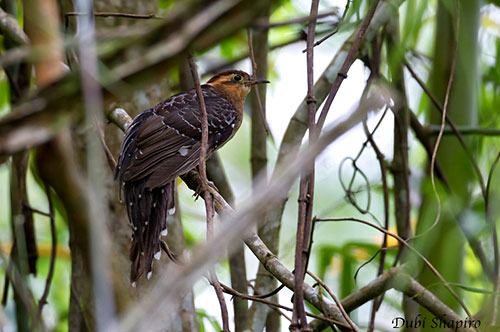
The juvenile is duller and greyer. The head is grey-brown with white eyestripe. On the upperparts, the wings are like in adults, but the back is blackish with some pale-edged feathers. Throat and breast are greyish. The tail lacks the white tips.
RANGE:
The Pavonine Cuckoo is patchily distributed in South America, from Colombia, Venezuela and Guyana, through E Peru and Bolivia to Brazil, Paraguay and N Argentina. There is only one record in E Ecuador (Napo).
HABITAT:
The Pavonine Cuckoo usually frequents tall forests such as lowland and montane evergreen forests, scrub thickets, dense brushy areas, tangled forest, dense patches of second growth, and seasonally flooded forests along rivers with abundant Heliconia and Ficus trees.
This species occurs from lowlands to 1,600 metres of elevation, but occasionally higher in Venezuela, up to 1,900 metres or more.
CALLS AND SONGS: SOUNDS BY XENO-CANTO
The Pavonine Cuckoo gives whistled but not trilled “puu-pee…puh-pee pee” at large intervals and generally higher-pitched than Pheasant Cuckoo. These notes are far-carrying, with first and third notes lower pitched than others.
BEHAVIOUR IN THE WILD:
The Pavonine Cuckoo feeds on large insects such as grasshoppers, cockroaches, cicadas and beetles. It also takes spiders, scorpions and millipedes.
It feeds solitary by walking on the ground in forest understorey. While walking, it often opens both wings and large alula.
During the breeding season, it sings all day long. Outside this period, it can be heard before dawn and at dusk, and sometimes during the night.
While calling, the large alula is extended and vibrating. The long tail is lowered but the long uppertail-coverts are puffed out. It usually sings from perch in dense cover.
The Pavonine Cuckoo is resident in the wide range.
It may sometimes fly with slow wingbeats. The wings are raised above the back and held for a moment, while the tail is slightly spread.
When alarmed, the crest is erected and the tail is fanned and raised. It reaches the undergrowth almost without wingbeats.
REPRODUCTION OF THIS SPECIES:
The Pavonine Cuckoo is a brood-parasitic species. The female lays her eggs (one per nest) mainly in closed or bag-shaped structures such as those of Formicariidae and Tyrannidae.
The eggs are white with purplish markings. After the young cuckoo hatches, the eggs and chicks of the host usually disappear, probably killed and removed by the young intruder.
PROTECTION / THREATS / STATUS:
The Pavonine Cuckoo is threatened by habitat loss and disturbance caused by forest fragmentation.
The species is uncommon to rare, with very patchy distribution. But this bird is very secretive and probably overlooked.
The Pavonine Cuckoo is not globally threatened and currently evaluated as Least Concern, but the population is suspected to be declining.
Fr: Géocoucou pavonin
Ang: Pavonine Cuckoo
All: Pfauenkuckuck
Esp: Cuclillo Pavonino
Ita: Cuculo pavonino
Nd: Pauwkoekoek
Sd: påfågelgök
Photographer:
Dubi Shapiro
Dubi Shapiro Photo Galleries & Dubi Shapiro's Pictures on IBC
Text by Nicole Bouglouan
Sources:
HANDBOOK OF THE BIRDS OF THE WORLD vol 4 by Josep del Hoyo-Andrew Elliott-Jordi Sargatal - Lynx Edicions - ISBN: 8487334229
Cuckoos of the World Par Johannes Erritzøe, Clive F. Mann, Frederik Brammer, Richard A. Fuller – Editeurs A&C Black, 2012 – ISBN: 1408142678, 9781408142677
The Cuckoos Par Robert B. Payne – Editeur: OUP Oxford, 2005 – ISBN: 0191513555, 9780191513558
Neotropical Birds – Cornell Lab of Ornithology
Wikipedia, the free encyclopaedia
Brood parasitism by the enigmatic and rare Pavonine Cuckoo in Amazonian Peru
Pavonine Cuckoo
Dromococcyx pavoninus
Cuculiformes Order – Cuculidae Family
INTRODUCTION:
The Pavonine Cuckoo is known to be a brood parasite included in the subfamily Neomorphinae of the New World ground cuckoos in the family Cuculidae. It is very similar to the Pheasant Cuckoo.
It is very patchily distributed in the northern half of South America where it frequents tall forests and secondary forest understorey. It feeds on large insects and spiders by walking on the ground.
The Pavonine Cuckoo is threatened by habitat loss and the population is suspected to be declining.
DESCRIPTION OF THE BIRD:
Biometrics:
Length: 27-31 cm
Weight: 40-54 g
The Pavonine Cuckoo has dusky upperparts, but the feathers have pale edges involving scaled pattern. The wings are dark greyish-brown with pale grey wingbar. The alula is large. The uppertail-coverts are black with small white spots at tips. The long, graduated tail is brown with white tips.
On the underparts, throat, neck sides and breast are uniformly buff to rufous, whereas the belly is white. The tail is mostly grey below but the white tips are visible.
The head is small, with rufous forehead, crown and short nuchal crest. We can see a long, buff, postocular eyestripe. Face and ear-coverts are dark rufous. Cheeks and faint malar stripe are dark chestnut.
The bill has black upper mandible, but the lower one is grey. The eyes are brown, surrounded by pale buff eyering. Legs and feet are grey.
Male and female are similar.
